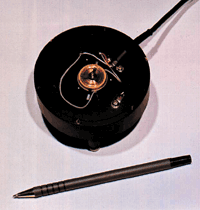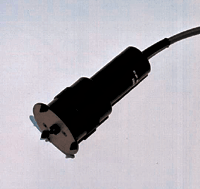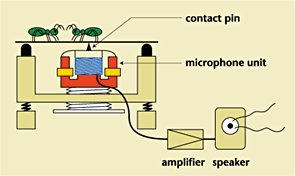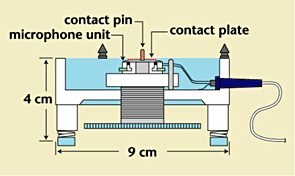|
Super-Sensitive
Contact Microphone
-"Insect Microphone"-
 |
|
Stationary type
|
 |
 |
| Portable
type |
A super-sensitive contact
microphone, called the
"Insect Microphone", can
pick up the footsteps
of crawling insects. It
was developed to convey
on television the reality
of the world of small
insects.
While an ordinary microphone
picks up sound vibrations
through the air, this
microphone picks up vibrations
conducted by a solid mass.
Air-borne sounds attenuate
more quickly than solid-borne
sounds. This microphone
picks up sounds before
they radiate into the
air, which means that
it can pick up minute
sounds that would otherwise
be inaudible in air.
The microphone uses a
moving-coil-type electroacoustic
transducer. Because it
is not necessary to have
a converting circuit that
changes the output impedance
of the transducer from
high to low, the microphone
noise is less than in
the electrostatic type
or piezoelectric type
of microphone. The noise
of the moving-coil microphone
is determined only by
the thermal noise of the
resistance of the coil.
Since this microphone
does not have the diaphragm
that an ordinary microphone
has to detect air vibrations,
its sensitivity is low
with respect to air-borne
sound. In fact, because
it is insensitive to air-borne
sound and sensitive to
solid-borne sound, it
can clearly detect the
sound of a small moving
object.
The microphone unit consists
of a magnetic circuit,
coil, contact plate and
contact pin. The contact
pin is attached to the
coil via the contact plate
and is the mechanism that
catches the vibration.
The position of the contact
pin is adjustable along
its axis in order that
it stays in contact with
the solid plate on which
the insect is crawling.
The vibrations of the
plate are conveyed to
the coil through the contact
pin. An electric current
is generated in the coil
as a result of the coil
moving in the magnetic
field.
When the contact pin is
shaken with constant acceleration,
output response decreases
in nearly inverse proportion
to the frequency of shaking.
The sensitivity is -58
dB (re: 1 V) at 1 kHz
and 0.1g (g=9.8 m/s2 :
acceleration due to gravity).
The 'Insect Microphone'
has been used to pick
up a snail's heartbeat
and footsteps of ants
and antlions.
Recently, a portable type
of insect microphone was
developed. This model
can be used in an outdoor
environment and can be
put in direct contact
with objects or attached
to a microphone stand.
 |
 |
 |

Operational
concept of insect microphone
|
 |

Schematic
diagram of insect
microphone
|
|

